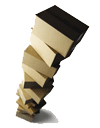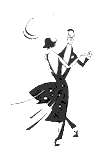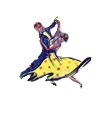When you walk from the den into the kitchen for an evening snack, you can amble and slouch in pretty much any way that seems comfortable to you. A well-meaning parent or spouse might urge you to straighten up, but the issue is not top-priority. On the dance floor, though, good posture is important. For one thing, dance is not just a way to get from here to there. Dance is an art form, and we want to look good. We want to paint an attractive picture, even a masterpiece. Secondly, we are not moving alone—we are part of a partnership—and good balance and good posture contribute much to smooth and comfortable dancing.
BEFORE YOU MOVE—
 One of the images that comes up again and again in the smooth rhythms, like foxtrot and waltz, is the idea that the dancer's body is like a pile of boxes—crates stacked in a warehouse—and it is important to keep the pile aligned and balanced.
One of the images that comes up again and again in the smooth rhythms, like foxtrot and waltz, is the idea that the dancer's body is like a pile of boxes—crates stacked in a warehouse—and it is important to keep the pile aligned and balanced.
 Another nice image is that of a pearl necklace or a string of beads hanging in a column. The first box or bead is the feet, then the knees, hips, torso, shoulders, and finally the head. One of the surprises is that the heaviest box in the pile is the head. It doesn't look that big, but if you throw it around, the whole pile is at risk. Wherever your head goes, the rest of you wants to follow.
Another nice image is that of a pearl necklace or a string of beads hanging in a column. The first box or bead is the feet, then the knees, hips, torso, shoulders, and finally the head. One of the surprises is that the heaviest box in the pile is the head. It doesn't look that big, but if you throw it around, the whole pile is at risk. Wherever your head goes, the rest of you wants to follow.
Of course, you can fight conflicting tendencies within your body. Perhaps the man is looking over toward the wall and idly admiring the snack table. No, let's make it more romantic—you are gazing lovingly into your partner's eyes. You will still be able to dance a reverse turn or an open telemark, but you will feel at least a little bit of conflict within your body, within your "pile of boxes." Your head is "going" one way (right, toward your partner), and your body is going the other way (left, into the open telemark). Your body will win. I suppose it is five boxes against only one (even though it is a big one). But you can eliminate even this little bit of conflict and smooth out your movements if you stay on your side of the partnership, stay in your space, and stay on balance. Look just a little to your left. Look over her right shoulder. That opening formed by the right side of her head and her right shoulder is your "window." Look out of your own window. She is doing the same thing—looking to her left and over your right shoulder. If you can stay in your own space and not intrude into your partner's space or in any way block your partner's window, then you will have better posture and smoother movements.
You may ask, how can I keep my boxes aligned, one on top of the other, and at the same time keep my head to the left and "looking out of my window?" There are two answers. First, we don't really want our boxes in an absolutely straight and vertical row. That would make us rigid and awkward (I think Frankenstein's monster had his boxes piled vertically). Instead, we want the whole pile on balance over our feet, but if the head is a little left, then the torso might be stretched a little on the right, in a gentle curve.
Second, the heavy part of the head is the back of the head. It bulges out back there and is full of heavy brains. The front of your head is merely your face. Facial bones are light and full of sinuses and nasal passages—full of air. So if we want good posture, we need to think not of the whole head, but the back of the head, and keep it centered over our spine. To move your head to the left, don't just turn or tilt your neck that way, as if you were trying to peek around a corner. Instead, rotate your neck and adjust your body so that your face is to the left but the back of your head is on balance.
One of our teachers reminds us to "keep your ponytail hanging down the center of your back." Men, you try to work with this image, too. If you simply turn your head to the left, your ponytail swings to the right and you are off balance. If you sharply tilt your head to the left, your ponytail swings left and again you are off balance. If you use a little right-side stretch and rotation to turn your body under your head, your head will move left, you will be looking left, but your ponytail will still be hanging down the middle of your back. You will be on balance.
 Don't just look to the left—look up and out too. A good spot to aim for is the angle between the wall and ceiling. Another image that we sort of like is that of an oscillating fan. Our fan is short. It sits on the floor in the summer, tilts up toward the people walking about, and it slowly sweeps back and forth, reaching from one side of the room to the other. The face of the fan sweeps from the right to the left, but the heavy motor in back stays relatively centered. So, three features of our posture are keeping the heavy part of the head on balance—the right-side stretch, the right-face body rotation, and the upward tilt of the head.
Don't just look to the left—look up and out too. A good spot to aim for is the angle between the wall and ceiling. Another image that we sort of like is that of an oscillating fan. Our fan is short. It sits on the floor in the summer, tilts up toward the people walking about, and it slowly sweeps back and forth, reaching from one side of the room to the other. The face of the fan sweeps from the right to the left, but the heavy motor in back stays relatively centered. So, three features of our posture are keeping the heavy part of the head on balance—the right-side stretch, the right-face body rotation, and the upward tilt of the head.
Certainly you mustn't look down. Don't look at your feet. Watching your feet will pull that top box right off the pile. You will clutch at your partner. You will pull your top-lines together, hang on each other, and pull each other off balance. Instead, keep your top-line—head, shoulders, arms—up and apart and balanced.
We're beginning to look at the second and third boxes in the pile now, too—the shoulders and the upper torso. We want them back, apart from those of your partner. For this to work, some other part of the pile must be in toward your partner, giving us overall balance, and that forward box must be your hips. So much of the man's lead comes through the hips. They must be in contact with your partner's. So much of the woman's ability to follow involves keeping her hips "glued" to her man's and her belly button aimed right at him. In closed position, her left hip should be just outside his right hip; her right hip should be in the hollow of his right hip—right in his "watch pocket."
We never lock our knees when we dance, so depending on the fall and rise at the moment, our knees will be more or less flexed, and they too will be a little forward in the pile of boxes. Our feet and especially our heels will be back. We can recognize two C-shapes in each dancer. There is a side-to-side "C" from the head, through the right-side stretch, hips, and back through the legs. There is a back-to-front "C" from the head, forward through the torso, hips, and back down the legs to the feet. Consider both together, and we get some kind of very gentle corkscrew. Let's go back to our string-of-beads image. Let's pull it tight and then let it relax just a little into these soft and graceful curves. We can't say that each bead is directly above the previous one, but the whole string is on balance.
MOVING—
Ordinary walking is sometimes described as "controlled falling." As you walk, the body is steadily falling forward, and you are repeatedly moving your legs to catch yourself and avert disaster. You fall, you catch, fall, catch, and lo-and-behold, you have "walked" across the room. But dancers try to progress more smoothly (at least in the "smooth" rhythms). Dancers don't fall toward their destinations—they glide. One way to do this is to dance the foot first, not the upper parts of the body. Don't lean in the direction you are going, and then bring your foot over and catch yourself with a "plop" or a jerk. Instead, lower into the supporting knee. This allows you to keep your upper body stretched up, your boxes aligned, while you reach out with your free foot. Test the waters ahead of you to see if they are really warm enough, before you commit your body to the plunge. When you are moving backwards, lower, reach back from the hip, and feel for any possible pothole or precipice, before you actually take that step. After you have begun to move your foot, you can begin to shift your hips, pushing gently through the supporting leg, and so keep your center of gravity solidly over its base of support. Lower, reach, and step.The more you lower, the farther you can reach and still remain upright and balanced. If you lower just a little and try to take a long forward step, you will lean over your partner and push her off balance. If you take a long backward step without sufficient lowering, you will pull her into you and she will push you off balance. A fundamental rule on the dance floor, as on the playground, is no pushing or shoving.
Given that the man is leading and the woman is following, each has a little different approach to this balance and movement. Where the man lowers and pushes himself forward, the woman lowers to free the stepping foot but then waits to feel the man's lead. She does push back with her supporting leg, but only to the degree that she feels the drive forward by the man. As long as she feels that drive, she allows her free foot to slide back. She does take that back step and shift weight, but only after she feels the man commit to his forward step.
The follower responds to the leader and mirrors his movements, but a balanced relationship shouldn't be one-way only. Sometimes, Meredith and I dance as though I am the hammer and she is the nail, but these moments don't feel good. Each of us needs to be aware of our partner, and we need to respond to each other. Each should adjust to and balance the other, giving the couple good posture and balance.
 So try some of this. Assume closed position. Both of you stretch up and arch back just a bit. Your hips are a little forward and in firm contact. Your upper bodies are apart, but each of your bodies is firmly balanced over your own feet. Your arms and overall frame are horizontal and firm, but neither is hanging on the other, or pushing or pulling, or in any way resting on the other. If one partner were to vanish, the other would not topple but would remain standing and stable. Finally, extend the body arch a bit to the left and put yourself clearly in your own space, looking out your own window.
So try some of this. Assume closed position. Both of you stretch up and arch back just a bit. Your hips are a little forward and in firm contact. Your upper bodies are apart, but each of your bodies is firmly balanced over your own feet. Your arms and overall frame are horizontal and firm, but neither is hanging on the other, or pushing or pulling, or in any way resting on the other. If one partner were to vanish, the other would not topple but would remain standing and stable. Finally, extend the body arch a bit to the left and put yourself clearly in your own space, looking out your own window.
Now, take a step. Lower and so extend the lead foot forward (woman back) without leaning forward or back. Only after the free foot has begun to move will you begin to propel your body forward with the supporting foot. In this way, the body remains between its points of support and on balance. Good posture and good balance will carry you well toward smooth and comfortable dancing.

from the the Dixie Round Dance Council
(DRDC) Newsletter, March 2006exerpt reprinted in Dallas Harvest Holiday
newsletter, January 2007
http://www.harvestholiday.com/


No comments:
Post a Comment